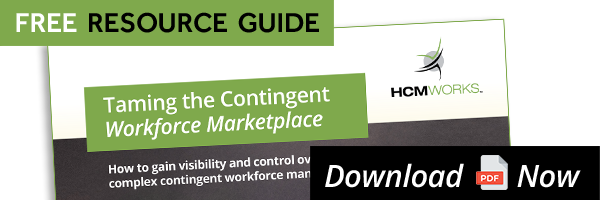When it comes to an organization’s contingent workforce program procurement and human resource (HR) professionals must strive for a transparent and company-wide strategy.
Whether your business is looking to create or improve your contingent workforce program, it can be a time-consuming and frustrating process. However, with contingent workers making up a large part of many companies’ workforce, updating the program you use to manage them is essential for acquiring the best talent and reducing costs.
Optimizing and automating your contingent workforce program will bring your company workforce agility, cost efficiencies, access to top talent, an improved bottom line and a company-wide approach that brings all departments in line with the same hiring, payment and compliance practices.
Implementing statement of work (SOW) into your contingent workforce strategy will help you optimize your contingent worker relationships.
What is a Statement of Work (SOW)?
A statement of work is a formal document used for contingent workers, in which the employer explains to the contractor the expectations, work activities, deliverables, timelines and payments for the work that is to be performed.
The SOW is not a legal contract, but it’s used to ensure the contingent worker understands the needs and expectations of the employer, in order to make sure that there are no miscommunications or misunderstandings about what is expected.
There are three separate types of statement of work:
- Design or detail statement of work: This formal document defines the exact requirements that are needed, and includes the precise measurements, materials to be used, necessary tolerances, quality control requirements and any other specifications that a worker might need to perform his/her job.
- Level of effort, time and materials or unit rate statement of work: This SOW document, which is used for pretty much any kind of service, highlights the time spent on the work and the materials needed for the job.
- Performance-based statement of work: A performance-based SOW does not provide details about how the work needs to be accomplished. However, this type of SOW clearly described the performance objectives and standards that are expected of the contractor. This is the preferred document for most companies.
How do I create a SOW?
It’s fairly easy to create your own generalized or specialized statement of work, and there are various templates that you can find online in both the US and Canada.
A SOW should address certain areas of the contractor's project. This could include the purpose of the project, the scope of work being done, the location of the work being performed, the time period for the project, expected deadlines and deliverables, timelines for reviews and the standards that must be met.
It sounds simple, but writing a SOW is much harder than it looks. There’s no room for misinterpretation or poor writing. If your contractor can in any way misinterpret their task then your company will be at fault for this and will take responsibility.
What are the benefits of a SOW?
An effective statement of work must be detailed, precise and use easily understandable language. Once this has been created, implementing SOW into your existing or updated contingent workforce management strategy comes with numerous benefits, with the top two being:
Mitigating risks: Perhaps the most valuable reason of those is to mitigate the increased legal and compliance liabilities associated with hiring non-permanent workers. Including all of your information in a SOW will make sure you are covered for insurance reasons, as well as fines, penalties and lawsuits. Having proof of your contractor’s project will mitigate you from risks and protect your company from serious liability issues.
Data analysis: Many companies hire contingent workers on a departmental basis, meaning data is fragmented and different departments have different processes behind the hiring of contingent workers. Through a statement of work you are collecting the information that makes your company’s contingent workforce more visible, such as hours worked, material costs, worker pay, and background checks. With this data you can analyze contractors’ performance, maximize productivity and reduce rogue spend.
What organizations often forget, is that non-permanent workers are not exclusively sourced under time and material (hourly rate) engagements. Instead, they are often packaged, and hidden, inside agreements known as a Statement of Work (SOW).
Organizations looking to truly optimize their contingent workforce management programs, need to ensure that all non-employee workers are visible, managed and accounted for.
Depending on the maturity of your contingent workforce management program and objectives, it may be the right time to build or expand your program to centralize and manage your Statement of Work (SOW) engagements for contingent labor.
Implementing SOW to your contingent workforce program will add an extra layer of complexity, and could even hit your business with some pushback, but, once set up, the benefits are undeniable.
Why work with HCMWorks to help manage your SOW spend?
HCMWorks, with its long-standing knowledge of services procurement, can help you manage your total human capital spend. We help you build a comprehensive contingent workforce strategy to gain full visibility into your entire non-employee human capital base.
By developing a comprehensive SOW strategy you ensure an end-to-end human capital solution for contract controls, management of supplier performance and population, strategic sourcing, reduced spending, compliance, improved security and risk mitigation.
Having full visibility in your entire contingent workforce with SOW spend management will allow you to maximize productivity, make informed hiring decisions, and see performance issues ahead of time before they affect your bottom line.
Ready to learn how to manage your SOW spend? Contact HCMWorks today and we will help you to create a comprehensive SOW strategy that will ensure your company reduces spending, and improves compliance and visibility.



